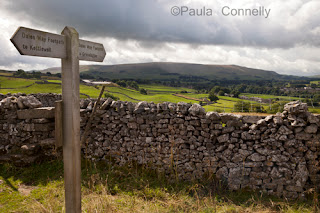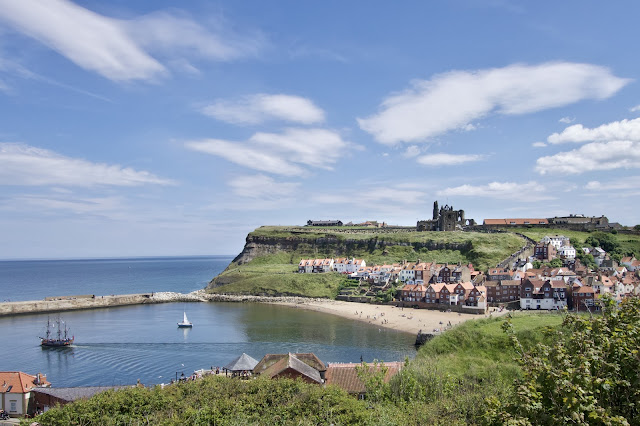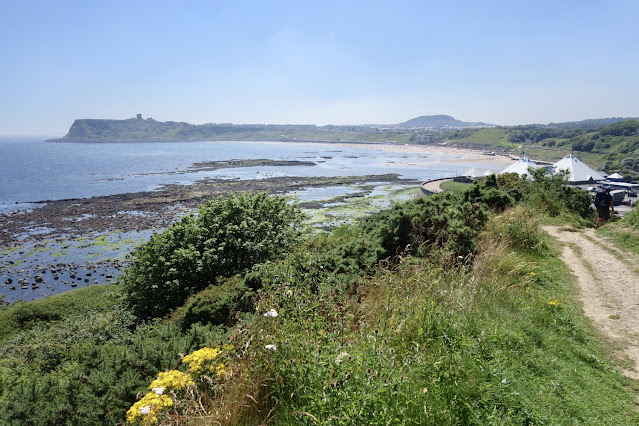Grassington & Mossdale Scar
Our trip to Pen-y-Ghent called for an overnight stay so that
we could enjoy a second day's walking in the beautiful Yorkshire Dales. We chose to stay in the popular Dales village
of Grassington and to walk a circuit of 12 miles directly from Grassington, taking
in the dramatic and tragic Mossdale Scar.
The forecast was for a chance of showers but the day started
out with bright sunshine, providing perfect lighting to pick out the drystone
walls and barns for which the Yorkshire Dales are famous.
Soon after climbing out of Grassington the terrain became gradually more rugged and we started to see exposed sections of limestone.
The Great Scar
Limestone of the Yorkshire Dales was laid down on seabeds some 300 million
years ago . During the last ice age
glaciers scraped away the surface exposing the natural joints in the underlying
limestone rock. Slightly acidic rain dissolved these vertical joints creating
the limestone clints and grikes (blocks and the crevices in between), which
make up the limestone pavements and I was particularly keen to photograph a section
of pavement above Conistone, a few miles north of Grassington.
The soils lying
over this rock are usually very thin and of low fertility and, in combination
with consistent grazing, often results in a rich diversity of lime loving
grasses, ferns and wildflowers for which the limestone country of the Dales is
famous.
We lingered a
while around this lovely stretch of pavement so I could capture as many
photographs as possible before the weather closed in, then from here we walked
a further couple of miles to Mossdale Scar.
The wind picked up and rain clouds gathered ominously as we sheltered in
a grouse butt to eat our lunch.
As we made our
way down to Mossdale Scar it began to pour with rain. This was unfortunate as I was hoping to take
some photographs, but it was also fittingly poignant.
Mossdale Scar is
a limestone cliff below which the Mossdale Beck disappears underground to
emerge at Black Keld nearly three miles away.
Exploration of the cave system of Mossdale Caverns was begun in 1941 and
continued until tragedy struck on 24th June 1967. On this day ten young cavers entered the
caverns to begin an exploration. Three
hours later four of the party left the cave and shortly afterwards it began to
rain heavily. One of the party who had
left the cave returned to the entrance to discover the beck had broken its
banks and the entrance to the caverns was completely submerged. She raised the alarm and a rescue attempt was
undertaken which lasted throughout the night and into the following day and
involved a large group of people diverting the course of the beck so that an
attempt could be made to reach those trapped inside. Sadly, when rescuers were eventually able to
enter the caverns, all six of the young men trapped inside were found to have died. Due to the difficulty of bringing
their bodies out through the narrow tunnels, the coroner decided that they
should be left in situ, the cave sealed off and declared a grave. A plaque in memory of this tragic event (the
worst in caving history) was later placed on the cliff above the cavern
entrance.
We sheltered for
a while under the cliff of Mossdale Scar until the rain began to ease. It felt strange and eerie, knowing that while
we stood there beneath our feet lay the bodies of those six young cavers and
although it was a beautiful and atmospheric place, I was a little relieved to
move on.
From Mossdale it
was a steady tramp across moorland down to Grassington through intermittent
rain showers and back to the pub for a change into dry clothing and a welcome
pint of the Grassington Ale (a locally brewed beer which is truly delicious).
I've done many
walks this year and I think this one remains my favourite. It was both beautiful and sad. And I have every intention of returning to
Mossdale Scar before long so that I can take some photographs and pay my
respects again to those six young men who lie beneath the limestone.










Comments
Post a Comment